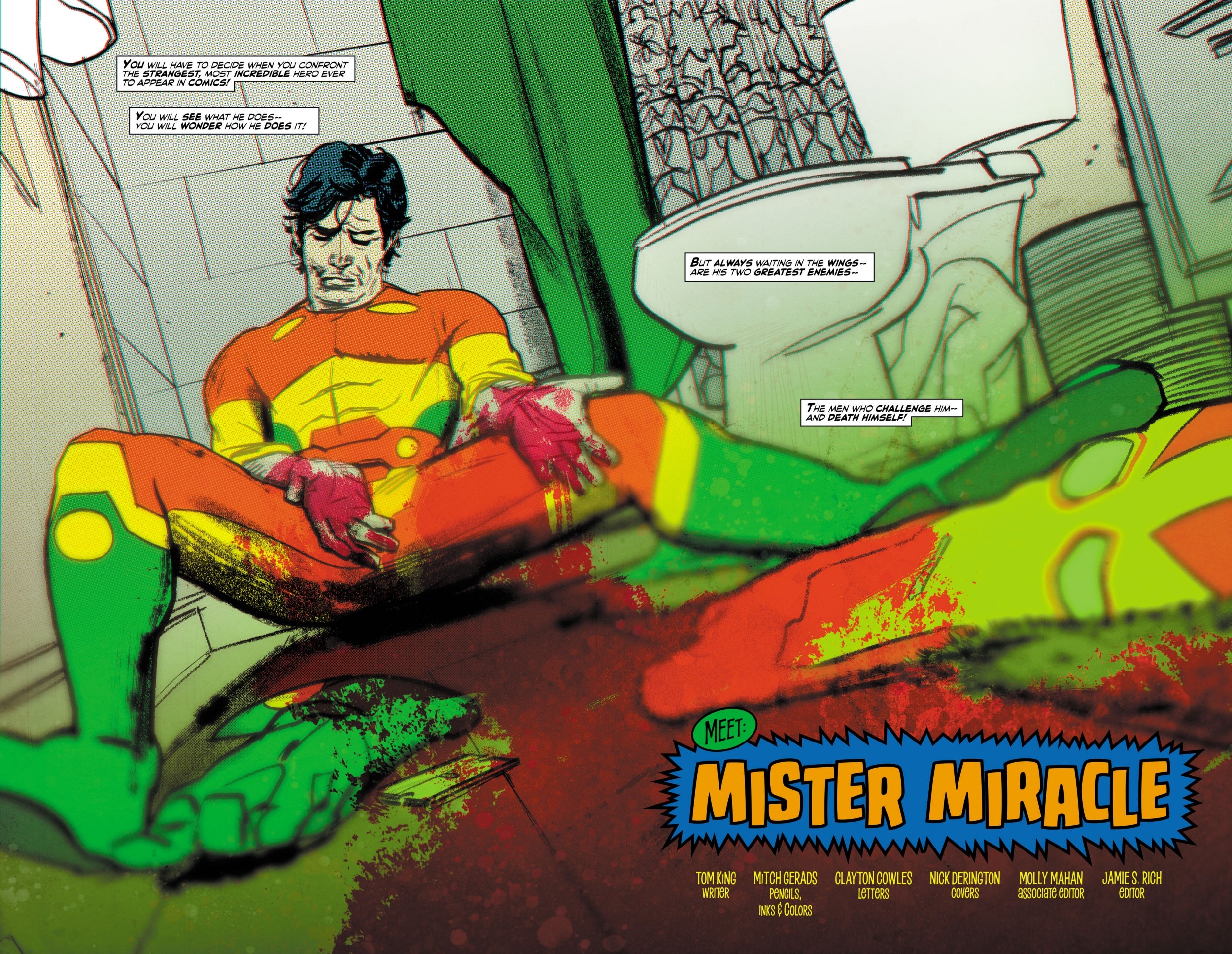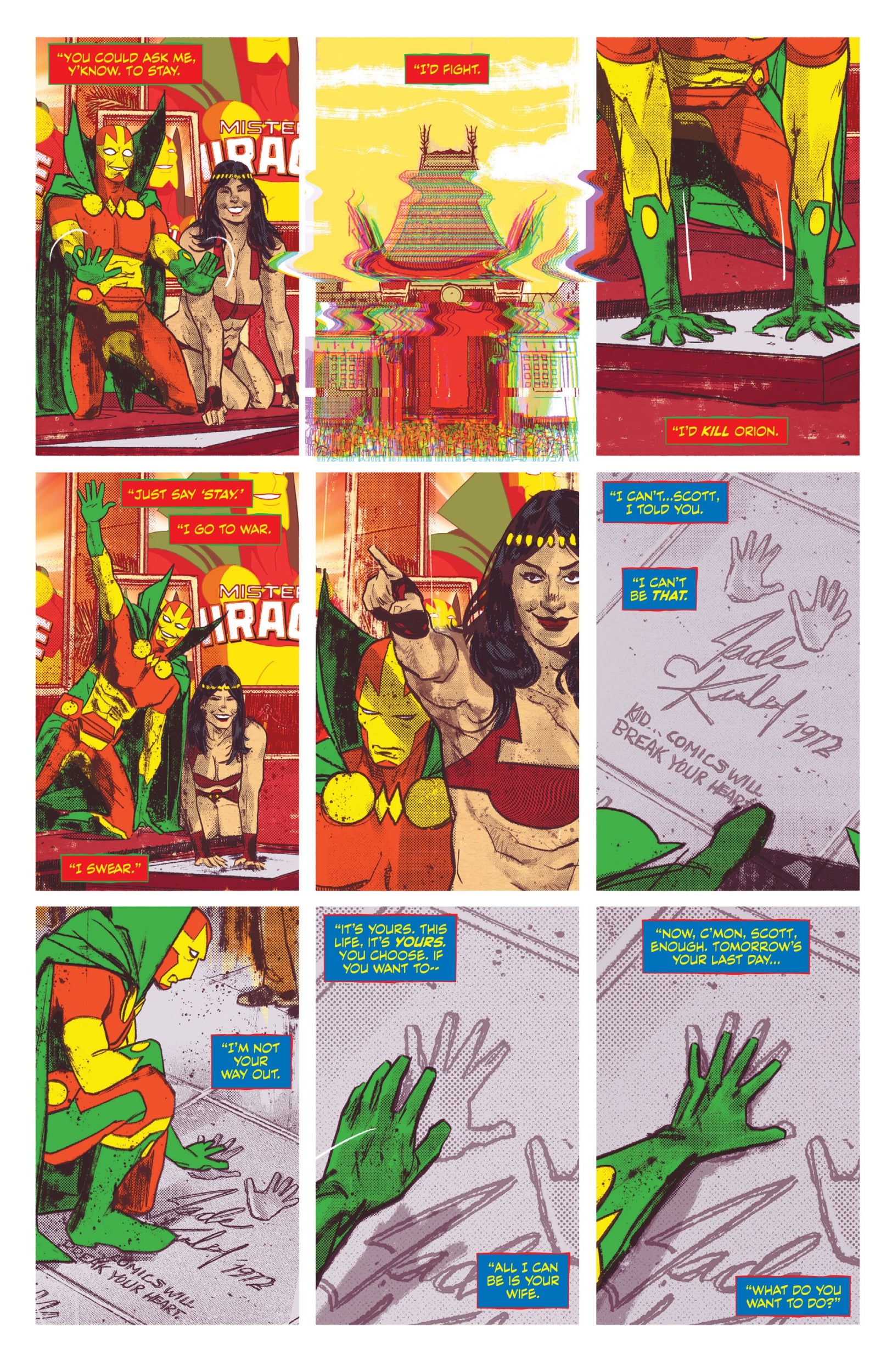Mister Miracle: Writer Tom King on his journey from comics to the CIA and back again
When asked if he’ll have to kill David Barnett if he tells him too much about his career in intelligence, King’s answer is simple: ‘No, they’ll have to kill me’


Writers are often told to write what they know. If you’re a creator of comic books featuring the adventures of super-powered, costumed heroes, that might be a difficult rule of thumb to apply. But perhaps not for Tom King. In Mister Miracle, from DC Comics, King and artist Mitch Gerads have created one of the most critically acclaimed graphic novels of the last year, and for the Washington-based writer, he drew on experiences that not a lot of other creators working in the field today have access to.
King, 40, who was born in California, spent several years as a counter-terrorism officer for the CIA, working out in the field in Iraq and Afghanistan. It’s fascinating to think about what King saw and did, and how that later informed his writing. Obviously, I suggest, if he tells me too much about it he’ll have to kill me. He’s heard that one before, of course, probably more times than he can count. “No,” he says, with what feels like an oft-trodden out reply, “if I tell you too much about it, they’ll have to kill me.”
Born to a film-writer mother in Southern California, King developed a love of storytelling and an understanding of narrative from an early age. During the 1990s he interned at the offices of the two big comics publishers, Marvel and DC. His ambition, though, was to become a lawyer and he graduated from Columbia University in the year 2000, intending to follow this path. He started working for the Justice Department.
And then came 11 September. Like everyone else in America, King was appalled and shocked and numbed. But he also knew he wanted to do something in response. So he went on to the CIA website and discovered that they were recruiting.
“They were looking to bring in a new generation of operatives to serve in this new world,” he says. “They wanted people who were good at connecting the dots. I went in maybe hoping to get a job as an information guy, I took the psych tests, and ended up as an operations officer.”
King worked out in the field in Afghanistan and Iraq for seven years, and the exact nature of his work out there is necessarily vague. When his wife fell pregnant with their first son (they have three children now) he knew he had a difficult decision to make.
“The part of the job I loved was being overseas, out in the war zone, as bizarre as that might sound,” he says. “But I knew I didn’t want to do that and have a family. I didn’t want to be away from my wife and kid for a year at a time.”
Returning to the US, King didn’t resume his plan to become a lawyer but instead turned to his first love, writing. But he wasn’t back in the world of comic books just yet… or at least, not quite. King wrote a prose novel, but about superheroes. A Once-Crowded Sky was published in 2012, to good notices. Writing about superheroes had regalvanised his love of comics and opened the door for him to work at DC.
His first gig was a series about Dick Grayson, the original Batman side-kick Robin who grew up and adopted a new persona, Nightwing. Co-written with Tim Seeley with art by Mikel Jannen, the series was the first time that King was able to draw on his CIA past, as the character quit the superhero business to become a spy.

That led to more work, and to the series that first brought King to wider notice – and his first collaboration with Mitch Gerads, his Mister Miracle co-creator. Published in late 2015, The Sheriff of Babylon was a critically-acclaimed crime series about a San Diego cop who becomes a military consultant in Iraq and has to solve the murder of a young local police trainee.
More work followed, with King getting to write characters both classic and obscure, from Batman to the Omega Men for DC, and the Vision (the character played by Paul Bettany in The Avengers movies) for Marvel.
Which led to King and Gerads working together again on what has become one of the most well-received comic books in recent years, earning plaudits from mainstream reviewers and publications especially… Mister Miracle.
Mister Miracle is a character who was first introduced in 1971, created by the towering genius that was Jack Kirby for DC comics. Real name Scott Free (ouch. But it was the 1970s, and King and Gerads do a fine job of contextualising that), Mister Miracle is billed as a “super escape artist”, Houdini in a cape and mask and yellow, green and red livery. He’s always been one of those B-List characters, except to the most devoted fans, in terms of recognisability.
But in an age where, thanks to the big comics companies mining their intellectual properties and breathing fresh life and mainstream appeal into characters formerly known only to the cognoscenti – Guardians of the Galaxy, anyone? Ant-Man? Black Panther? Aquaman? Suicide Squad? – even the non-rabid comics fan seems more willing to accept stories featuring characters who aren’t Superman, Batman, Captain America or Spider-Man.
Still, a super escape artist in a garish costume. Possibly limited scope there for anything beyond a series of set-piece daring feats, you might think. Which is possibly why Mister Miracle won so much praise by being one of the most literary and absorbing stories released by DC in some years.
It opens with a shocking image… the titular character slumped on his bathroom floor, wrists cut and bleeding out over the tiles. Yes, it begins with a superhero attempting to commit suicide.
“Scott Free can escape from anything,” says King. “So we thought… he’s going to keep pushing it, trying to escape from more and more difficult situations. And eventually he thinks, can I escape from death?”

King and Gerads had wanted to work on another big series after the Sheriff of Babylon, and initially they pitched an idea for a Batman comic but focussing on two big villains, the Joker and the Riddler. However, the characters were already earmarked for a storyline in the main Batman comic, so it was vetoed. DC, however, threw them another option.
Gerads says, “I got a call from Tom and he told me that we couldn’t do the Batman story. He said what would your second choice be, and straight away I said Mister Miracle.” Gerads pauses. “That’s absolutely true. And Tom said, well, that’s what they’ve offered us. And he sent me the pitch and the first line was, ‘Mister Miracle attempts suicide’.”
Starting from that dark place, the story then expands out into an exploration of, really, the anxieties of living in the modern era. Scott Free is married to the unlikely-named Big Barda, and they are attempting to navigate the mores of family life in present-day Los Angeles. But Scott and Barda are also not of this Earth.
Original Mister Miracle creator Jack Kirby dreamed up for DC comics in the 1970s a series of books that became known as the Fourth World, existing within the normal DC continuity of Batman and Wonder Woman, but also slightly apart from it. It focussed on two worlds, New Genesis, where the benevolent New Gods lived, and Apokolips, brutal realm of the tyrannical Darkseid. New Genesis and Apokolips are perpetually at war, and in a bid to broker peace, their rulers Darkseid and the Highfather agree to swap infant sons. Scott Free is the child of New Genesis, brought up in the hellish Apokolips, where he learns his craft and meets Barda, one of the fearsome Female Furies. Together they escape, and make a new life on Earth, but are called back into the war, which is where we find them in this story.
Mister Miracle was originally released as a 12-issue monthly series, and has just now been collected into a single volume. But it was always meant to be read as a graphic novel. King says, “It’s like a Dickens novel, which were originally serialised. It’s meant to be read as one story.” He pauses. “Not that I’m comparing myself to Dickens, obviously.”
The story is a mix of domestic life and the horrors of war. In one memorable scene, Scott and Barda fight their way over several pages through the terrors of Apokolips, holding a conversation as they do about redecorating their condo flat, building up to the tender moment – delivered as each character despatches bad guys in a sequence that looks like a platform video game – that Barda reveals she is pregnant.
Mister Miracle is a very personal book for both King and Gerads. The sheer exhausting nature of war comes across in several scenes, obviously drawn from King’s experiences. And Gerads’ son was born right in the middle of him working on the series, adding extra dimension to the point where Barda gives birth.

It should be noted that comics are a very collaborative medium, and King and Gerads worked closely on the distinctive look of the story. The trend in comics these days is for big, break-out images, kaleidoscopic panels, imaginative layouts. With Mister Miracle, the team went for a nine-panel grid, most closely associated with the classic of the genre from 30 years ago, Alan Moore and Dave Gibbons’ Watchmen.
That’s perhaps informed the mainstream success of Mister Miracle. It might be an odd thing to say, but reading comics is a learned skill, and not everybody gets on with the medium. A strict page design allows for easier digesting of the narrative. Gerads says, “Some people in comics think doing a grid like this must be very constricting for the artist, but that’s not the case. The magic with this is that you know exactly how the reader is going to read your page.”
King likens it to “almost like three Charlie Brown cartoons on each page, three panels each, and everybody knows how to read those”.
Aside from being a meditation on war and a domestic drama with dialogue that would satisfy any Netflix drama binge-watcher, there’s also a bigger storyline at play in Mister Miracle. To wit, is any of it actually happening? Is it all, in fact, the dream of a superhero who’s lying on his bathroom floor, his life slowly ebbing away?
“Living life is full of ambiguities,” says King, perhaps a little ambiguously himself.
Gerads is more forthcoming, and points out that Scott Free is in every single scene in the story. “We never leave Scott’s side in the entire book, we go on this ride with Scott through the story. Perhaps by the end Scott realises that it doesn’t matter if it’s real or not, because one way or another this is what he’s lived through.”
It was announced last year that one of DC’s next big movie projects will be based on the New Gods world, with Ava DuVernay (A Wrinkle In Time) lined up to direct. Rumours emerged in the last few weeks that Scott Free and Big Barda will actually form the central focus of the movie. Whether it will end up as an adaptation of this story, neither King nor Gerads could say, but if it does it could end up DC’s most interesting movie yet.
King and Gerads are hatching another collaboration for DC, which they aren’t at liberty to discuss (though King drops the hint that there’s a clue within Mister Miracle as to what that might be) and in the meantime, King is writing for the publisher Heroes in Crisis, which deals with the post-traumatic stress disorder that could actually affect superheroes given the ongoing violence and battles they deal with on a daily basis.
Does he find writing about the things he’s seen and experience during his time with the CIA cathartic? Or is it painful? Perhaps a bit of both, he says.
“I think me writing about war has been more necessary than anything else,” he says. “War and the damage that war does has formed the basis for a lot of my work. I write to give my kids a better life and the best thing for me has been to draw on what I’ve done. But I think I might be ready to talk about something else, now.”
Mister Miracle by Tom King and Mitch Gerads is out now and published by DC Comics.
Join our commenting forum
Join thought-provoking conversations, follow other Independent readers and see their replies
Comments
Bookmark popover
Removed from bookmarks